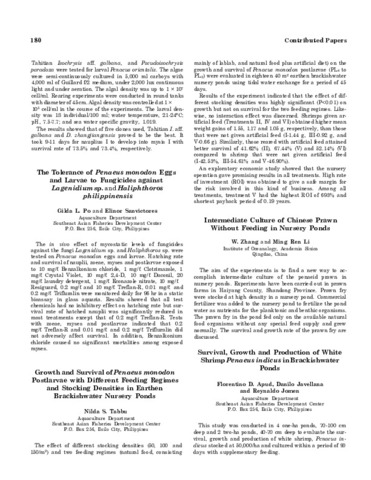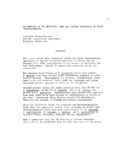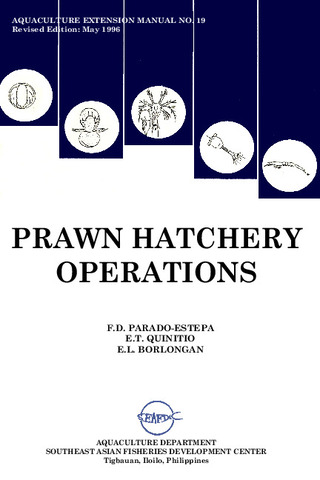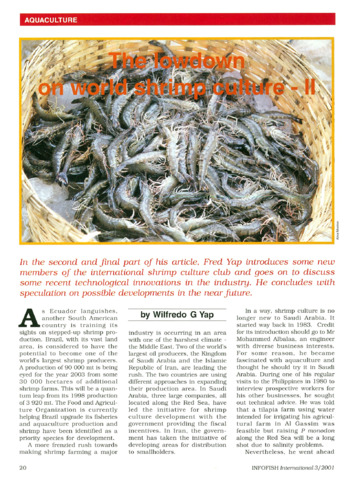Growth and survival of Penaeus monodon postlarvae with different feeding regimes and stocking densities in earthen brackishwater nursery ponds
- Global styles
- MLA
- Vancouver
- Elsevier - Harvard
- APA
- Help

วันที่
1985ผู้เขียน
Page views
5,048AGROVOC keyword
Taxonomic term
เมตาดาต้า
แสดงระเบียนรายการเต็ม
Share
นามธรรม
The effect of different stocking densities (50, 100 and 150/m2) and two feeding regimes (natural food, consisting mainly of lablab, and natural food plus artificial diet) on the growth and survival of Penaeus monodon postlarvae (PL4 to PL5) were evaluated in eighteen 40 m2 earthen brackishwater nursery ponds using tidal water exchange for a period of 45 days.
Results of the experiment indicated that the effect of different stocking densities was highly significant (P<0.01) on growth but not on survival for the two feeding regimes. Likewise, no interaction effect was discerned. Shrimps given artificial feed (Treatments II, IV and VI) obtained higher mean weight gains of 1.55, 1.17 and 1.05 g, respectively, than those that were not given artificial feed (I-1.44 g, III-0.92 g, and V-0.66 g). Similarly, those reared with artificial feed attained better survival of 41.62% (II), 67.44% (V) and 52.14% (VI) compared to shrimp that were not given artificial feed (I-42.53%, III-54.61% and V-46.90%).
An exploratory economic study showed that the nursery operation gave promising results in all treatments. High rate of investment (ROI) was obtained to give a safe margin for the risk involved in this kind of business. Among all treatments, treatment V had the highest ROI of 693% and shortest payback period of 0.19 years.
Description
Abstract only.
การอ้างอิง
Tabbu, N. S.(1985). Growth and survival of Penaeus monodon postlarvae with different feeding regimes and stocking densities in earthen brackishwater nursery ponds. (Abstract only). In Taki Y., Primavera J.H. and Llobrera J.A. (Eds.). Proceedings of the First International Conference on the Culture of Penaeid Prawns/Shrimps, 4-7 December 1984, Iloilo City, Philippines (p. 180). Iloilo City, Philippines: Aquaculture Department, Southeast Asian Fisheries Development Center.
Type
Conference posterISBN
9718511008
Related items
Showing items related by title, author, creator and subject.
-
An overview of the nutrition, feed and feeding techniques of prawn penaeid/shrimps
Piedad-Pascual, Felicitas (Philippine Council for Aquatic and Marine Research and Development, 1989)This paper echoes what transpired during the first International Conference of Penaeid Prawns/Shrimps held in Iloilo City in December 4-7, 1984, particularly on the Nutrition nd Feed Development. Around 25 papers were ... -
Series: Aquaculture extension manual; No. 19
Prawn hatchery operations
Parado-Estepa, Fe D.; Quinitio, Emilia T. ; Borlongan, Emeterio L. (Aquaculture Department, Southeast Asian Fisheries Development Center, 1996-05)
The manual, an updated version of the 1984 SEAFDEC/AQD manual, presents the underlying principles and step-by-step instructions of prawn larval and post-larval rearing. The techniques described are not only applicable to ...
; Borlongan, Emeterio L. (Aquaculture Department, Southeast Asian Fisheries Development Center, 1996-05)
The manual, an updated version of the 1984 SEAFDEC/AQD manual, presents the underlying principles and step-by-step instructions of prawn larval and post-larval rearing. The techniques described are not only applicable to ... -
The lowdown on world shrimp culture - II
Yap, Wilfredo G. (INFOFISH, 2001)This paper introduces some new members of the international shrimp culture club and goes on to discuss some recent technological innovations in the industry, particularly the polyculture of tilapia (mainly Oreochromis ...






